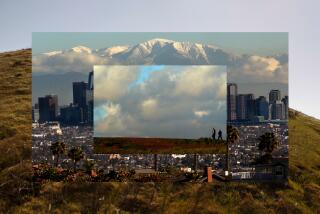Commuters’ Peculiar Twists and Turns in Going Over the Hill : CITY SMART: How to thrive in the urban environment of Southern California
- Share via
A great ridge of rock lies between the breakfast table and office for thousands of commuters in Southern California. The challenge for bleary-eyed travelers between the San Fernando Valley and the Westside: How to get over it.
For many, the Hollywood and San Diego freeways that strike through the Santa Monica Mountains are not an option, for they are too congested, too slow, too far out of the way.
Increasingly, the answer is to head for the hills.
As a result, narrow, twisting roads with bucolic names such as Laurel Canyon, Coldwater Canyon, Beverly Glen and Outpost have become jammed top to bottom during rush hour, much like their 10-lane siblings to the east and west.
Noisy, scary and practically unstoppable, the situation has made hill dwellers restless and angry. Although they realize that the rest of the city has the right to cross their neighborhoods as a path to flatter pastures, they wish that motorists would at least learn rules of the mountain road.
The main complaints: Commuters drive too fast or too slow, they cut corners, they tailgate, they ignore signs prohibiting smoking and, potentially worst of all, they snub pedestrians and other potential obstacles.
“Mountain driving requires a degree of perfection that’s not normally required on surface streets and freeways,” said Arthur L. Anderson, director of the state’s office of traffic safety.
Tarkus Piper, a 21-year-old environmental worker who picks up roadside trash in Coldwater Canyon twice a month, winces when he describes commuters.
“They see people in the street and they think you’re some kind of vagrant,” he said. Indeed, canyon roads are among the most hazardous byways in Los Angeles--far outpacing freeways in accidents per mile traveled.
Which are the most popular and dangerous?
According to the most recent city Department of Transportation statistics, Laurel Canyon attracts the most commuters--with 29,101 vehicles making trips each day. Tailgating behind are Beverly Glen, with 28,622 vehicles, and Coldwater Canyon, with 23,261 vehicles.
The good news about safety on these roads: Department of Transportation statistics suggest that if you manage to turn onto them through a Ventura Boulevard or Sunset Boulevard intersection, your chances of an accident plunge.
The potential dangers would never keep canyon-driving aficionados like Michael Healy and Ian Strang from their daily round trips.
Strang, a runner at a film production company, said he cuts half an hour off his commute if he takes Coldwater Canyon north from his home in Palms to his office in Studio City.
“I really hate the freeways--it’s so annoying to sit there and not be able to get off and take an alternate route if it jams up,” he said.
Likewise, Healy figures he trims 15 minutes off his morning drive by improvising a secret, serpentine path from his home in Studio City to his office at CBS Television City in the Fairfax district.
Healy acknowledges his imposition on canyon natives, but doesn’t let his pangs of guilt get in the way of his commute.
“I go slower than the speed limit because I’d hate if someone was commuting along my street,” he said. “People still give you dirty looks, but hell, I’m no Gandhi. I still go through.”
(BEGIN TEXT OF INFOBOX / INFOGRAPHIC)
Hillside Logjams
Roads such as Sepulveda Boulevard, Laurel Canyon Boulevard, Coldwater Canyon Boulevard, Beverly Glen Boulevard and Outpost Drive have become jammed top to bottom during rush hours, much like the nearby 405 and 101 freeways.
More to Read
Sign up for Essential California
The most important California stories and recommendations in your inbox every morning.
You may occasionally receive promotional content from the Los Angeles Times.













